
Preparation for dental surgery. Anesthesia. Modern technologies
Your oral health plays an essential role in your life. That is why keeping your mouth clean and free of harmful bacteria and infections is vital.
Your dentist will perform various preventive treatments to ensure your mouth is healthy. One of these measures is getting dental implants. Implants are strong attachments used to replace missing teeth.
A gum or bone graft is recommended if you are getting implants and need gum tissue. But what is a dental bone graft? Here are some things you need to know when getting a dental bone graft.
Consultation
Most bone grafts require the dental specialist to assess the area before grafting. This is to ensure the area is healthy and viable for the process.
During the consultation, the dental specialist will go over the details of the grafting process, including the expected results, the risks, and recovery time. They will also provide a detailed description of what to expect while the graft is in place. You could consider the best dental bone grafting found here for your initial consultation.
Preparation
It’s important to schedule an appointment with both your dentist and a specialist in advance. You must inform your dentist of your medical history and any allergies during the initial screening.
Meanwhile, during the evaluation, your dentist will measure the amount of bone needed for the graft and the type most appropriate for you. It is essential to ensure that you have stopped taking certain medications before the graft is performed and avoid smoking and drinking before and after it.
Additionally, you can plan for expenses associated with the bone graft and any healing time. With proper preparation and your dentist’s guidance, you can have successful dental work and restore your smile.
Dental Bone Graft Procedure
The actual dental procedures involve surgery, which may require either regional or general anesthesia. After the anesthesia has taken effect, the graft will be placed and sutured. The graft will be given time to heal and integrate with the existing bone before a restoration or implant is placed in the area.
Recovery
The time it takes to get better depends on the person and the surgery’s complexity. Still, it usually takes ten days and six weeks before normal things like eating and talking can be done again.
After the initial healing time, the gum tissue may still be sore and inflamed, and it may hurt to chew. However, these problems usually disappear after a few weeks as the tissue adjusts and strengthens.
Follow-Up Appointments
Patients must attend all follow-up appointments to ensure that the treated area can heal properly and effectively. Appointments are likely to involve a detailed examination of the graft and may also include X-rays and other imaging techniques to ascertain the progress of the ligaments and soft tissue surrounding the graft. Regular follow-up appointments are a vital step in the healing process and should not be skipped for any reason.
Know The Procedure!
A dental bone graft is a safe and effective procedure to help with smile restoration and the overall function of teeth and gums. To maximize the procedure’s success, patients should be aware of the potential risks and benefits associated with the surgery.
A dental professional can discuss the specifics of the treatment plan and any questions you have. So what are you waiting for? Contact your dental professional today!
Did you find the information in this article helpful? If so, check out our blog for more useful content and resources.
Leave a Reply